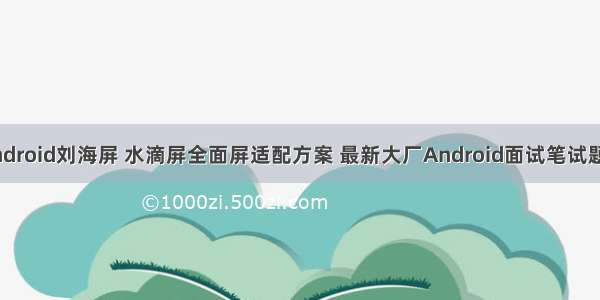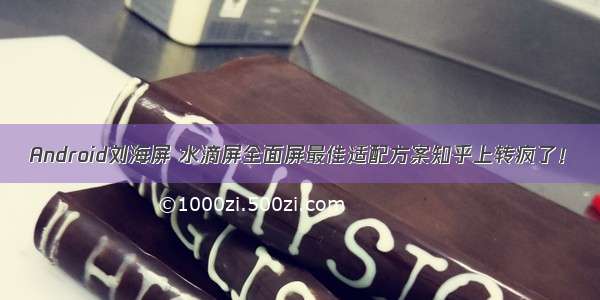
原文地址:/p/2b8db60ba8df
我将适配方案整理后,封装成了一个库并上传至github,可参考使用
项目地址: /smarxpan/NotchScreenTool
市面上的屏幕尺寸和全面屏方案五花八门。
这里我使用了小米的图来说明:
image
上述两种屏幕都可以统称为刘海屏,不过对于右侧较小的刘海,业界一般称为水滴屏或美人尖。为便于说明,后文提到的「刘海屏」「刘海区」都同时指代上图两种屏幕。
当我们在谈屏幕适配时,我们在谈什么
适应更长的屏幕防止内容被刘海遮挡其中第一点是所有应用都需要适配的,对应下文的声明最大长宽比
而第二点,如果应用本身不需要全屏显示或使用沉浸式状态栏,是不需要适配的。
针对需要适配第二点的应用,需要获取刘海的位置和宽高,然后将显示内容避开即可。
声明最大长宽比
以前的普通屏长宽比为16:9,全面屏手机的屏幕长宽比增大了很多,如果不适配的话就会类似下面这样:
image
黑色区域为未利用的区域。
适配方式
适配方式有两种:
将targetSdkVersion版本设置到API 24及以上
这个操作将会为<application>标签隐式添加一个属性,android:resizeableActivity="true", 该属性的作用后面将详细说明。
在<application>标签中增加属性:android:resizeableActivity="false"
同时在节点下增加一个meta-data标签:
<!-- Render on full screen up to screen aspect ratio of 2.4 --><!-- Use a letterbox on screens larger than 2.4 --><meta-data android:name="android.max_aspect" android:value="2.4" />
原理说明
这里涉及到的知识点是android:resizeableActivity属性。
在 Android 7.0(API 级别 24)或更高版本的应用,android:resizeableActivity属性默认为true(对应适配方式1)。这个属性是控制多窗口显示的,决定当前的应用或者Activity是否支持多窗口。
多窗口支持
在清单的<activity>或<application>节点中设置该属性,启用或禁用多窗口显示:
android:resizeableActivity=["true" | "false"]
如果该属性设置为 true,Activity 将能以分屏和自由形状模式启动。 如果此属性设置为 false,Activity 将不支持多窗口模式。 如果该值为 false,且用户尝试在多窗口模式下启动 Activity,该 Activity 将全屏显示。
适配方式2即为设置屏幕的最大长宽比,这是官方提供的设置方式。
如果设置了最大长宽比,必须android:resizeableActivity="false"。 否则最大长宽比没有任何作用。
适配刘海屏
Android9.0及以上适配
Android P(9.0)开始,官方提供了适配异形屏的方式。
Support display cutouts
通过全新的 DisplayCutout 类,可以确定非功能区域的位置和形状,这些区域不应显示内容。 要确定这些凹口屏幕区域是否存在及其位置,请使用 getDisplayCutout() 函数。
全新的窗口布局属性 layoutInDisplayCutoutMode 让您的应用可以为设备凹口屏幕周围的内容进行布局。 您可以将此属性设为下列值之一:
LAYOUT_IN_DISPLAY_CUTOUT_MODE_DEFAULTLAYOUT_IN_DISPLAY_CUTOUT_MODE_SHORT_EDGESLAYOUT_IN_DISPLAY_CUTOUT_MODE_NEVER
默认值是LAYOUT_IN_DISPLAY_CUTOUT_MODE_DEFAULT,刘海区域不会显示内容,需要将值设置为LAYOUT_IN_DISPLAY_CUTOUT_MODE_SHORT_EDGES
您可以按如下方法在任何运行 Android P 的设备或模拟器上模拟屏幕缺口:
启用开发者选项。在 Developer options 屏幕中,向下滚动至 Drawing 部分并选择 Simulate a display with a cutout。选择凹口屏幕的大小。
适配参考:
// 延伸显示区域到刘海WindowManager.LayoutParams lp = window.getAttributes();lp.layoutInDisplayCutoutMode = WindowManager.LayoutParams.LAYOUT_IN_DISPLAY_CUTOUT_MODE_SHORT_EDGES;window.setAttributes(lp);// 设置页面全屏显示final View decorView = window.getDecorView();decorView.setSystemUiVisibility(View.SYSTEM_UI_FLAG_LAYOUT_FULLSCREEN | View.SYSTEM_UI_FLAG_LAYOUT_STABLE);
其中延伸显示区域到刘海的代码,也可以通过修改Activity或应用的style实现,例如:
<?xml version="1.0" encoding="utf-8"?><resources><style name="AppTheme" parent="xxx"><item name="android:windowLayoutInDisplayCutoutMode">shortEdges</item></style></resources>
Android O 适配
因Google官方的适配方案到Android P才推出,因此在Android O设备上,各家厂商有自己的实现方案。
我这里主要适配了华为、小米、oppo,这三家都给了完整的解决方案。至于vivo,vivo给了判断是否刘海屏的API,但是没用设置刘海区域显示到API,因此无需适配。
适配华为Android O设备
方案一:
具体方式如下所示:
<meta-data android:name="android.notch_support" android:value="true"/>
对Application生效,意味着该应用的所有页面,系统都不会做竖屏场景的特殊下移或者是横屏场景的右移特殊处理:
<applicationandroid:allowBackup="true"android:icon="@mipmap/ic_launcher"android:label="@string/app_name"android:roundIcon="@mipmap/ic_launcher_round"android:testOnly="false"android:supportsRtl="true"android:theme="@style/AppTheme"><meta-data android:name="android.notch_support" android:value="true"/><activity android:name=".MainActivity"><intent-filter><action android:name="android.intent.action.MAIN"/><category android:name="android.intent.category.LAUNCHER"/></intent-filter></activity>
对Activity生效,意味着可以针对单个页面进行刘海屏适配,设置了该属性的Activity系统将不会做特殊处理:
<applicationandroid:allowBackup="true"android:icon="@mipmap/ic_launcher"android:label="@string/app_name"android:roundIcon="@mipmap/ic_launcher_round"android:testOnly="false"android:supportsRtl="true"android:theme="@style/AppTheme"><activity android:name=".MainActivity"><intent-filter><action android:name="android.intent.action.MAIN"/><category android:name="android.intent.category.LAUNCHER"/></intent-filter></activity><activity android:name=".LandscapeFullScreenActivity" android:screenOrientation="sensor"></activity><activity android:name=".FullScreenActivity"><meta-data android:name="android.notch_support" android:value="true"/></activity></application>
方案二
对Application生效,意味着该应用的所有页面,系统都不会做竖屏场景的特殊下移或者是横屏场景的右移特殊处理
我的NotchScreenTool中使用的就是方案二,如果需要针对Activity,建议自行修改。
设置应用窗口在华为刘海屏手机使用刘海区
/*刘海屏全屏显示FLAG*/public static final int FLAG_NOTCH_SUPPORT=0x00010000;/*** 设置应用窗口在华为刘海屏手机使用刘海区* @param window 应用页面window对象*/public static void setFullScreenWindowLayoutInDisplayCutout(Window window) {if (window == null) {return;}WindowManager.LayoutParams layoutParams = window.getAttributes();try {Class layoutParamsExCls = Class.forName("com.huawei.android.view.LayoutParamsEx");Constructor con=layoutParamsExCls.getConstructor(LayoutParams.class);Object layoutParamsExObj=con.newInstance(layoutParams);Method method=layoutParamsExCls.getMethod("addHwFlags", int.class);method.invoke(layoutParamsExObj, FLAG_NOTCH_SUPPORT);} catch (ClassNotFoundException | NoSuchMethodException | IllegalAccessException |InstantiationException | InvocationTargetException e) {Log.e("test", "hw add notch screen flag api error");} catch (Exception e) {Log.e("test", "other Exception");}}
清除添加的华为刘海屏Flag,恢复应用不使用刘海区显示
/*** 设置应用窗口在华为刘海屏手机使用刘海区* @param window 应用页面window对象*/public static void setNotFullScreenWindowLayoutInDisplayCutout (Window window) {if (window == null) {return;}WindowManager.LayoutParams layoutParams = window.getAttributes();try {Class layoutParamsExCls = Class.forName("com.huawei.android.view.LayoutParamsEx");Constructor con=layoutParamsExCls.getConstructor(LayoutParams.class);Object layoutParamsExObj=con.newInstance(layoutParams);Method method=layoutParamsExCls.getMethod("clearHwFlags", int.class);method.invoke(layoutParamsExObj, FLAG_NOTCH_SUPPORT);} catch (ClassNotFoundException | NoSuchMethodException | IllegalAccessException |InstantiationException | InvocationTargetException e) {Log.e("test", "hw clear notch screen flag api error");} catch (Exception e) {Log.e("test", "other Exception");}}
适配小米Android O设备
判断是否是刘海屏
private static boolean isNotch() {try {Method getInt = Class.forName("android.os.SystemProperties").getMethod("getInt", String.class, int.class);int notch = (int) getInt.invoke(null, "ro.miui.notch", 0);return notch == 1;} catch (Throwable ignore) {}return false;}
设置显示到刘海区域
@Overridepublic void setDisplayInNotch(Activity activity) {int flag = 0x00000100 | 0x00000200 | 0x00000400;try {Method method = Window.class.getMethod("addExtraFlags",int.class);method.invoke(activity.getWindow(), flag);} catch (Exception ignore) {}}
获取刘海宽高
public static int getNotchHeight(Context context) {int resourceId = context.getResources().getIdentifier("notch_height", "dimen", "android");if (resourceId > 0) {return context.getResources().getDimensionPixelSize(resourceId);}return 0;}public static int getNotchWidth(Context context) {int resourceId = context.getResources().getIdentifier("notch_width", "dimen", "android");if (resourceId > 0) {return context.getResources().getDimensionPixelSize(resourceId);}return 0;}
适配oppoAndroid O设备
判断是否是刘海屏
@Overridepublic boolean hasNotch(Activity activity) {boolean ret = false;try {ret = activity.getPackageManager().hasSystemFeature("com.oppo.feature.screen.heteromorphism");} catch (Throwable ignore) {}return ret;}
获取刘海的左上角和右下角的坐标
/*** 获取刘海的坐标* <p>* 属性形如:[ro.oppo.screen.heteromorphism]: [378,0:702,80]* <p>* 获取到的值为378,0:702,80* <p>* <p>* (378,0)是刘海区域左上角的坐标* <p>* (702,80)是刘海区域右下角的坐标*/private static String getScreenValue() {String value = "";Class<?> cls;try {cls = Class.forName("android.os.SystemProperties");Method get = cls.getMethod("get", String.class);Object object = cls.newInstance();value = (String) get.invoke(object, "ro.oppo.screen.heteromorphism");} catch (Throwable ignore) {}return value;}
Oppo Android O机型不需要设置显示到刘海区域,只要设置了应用全屏就会默认显示。
因此Oppo机型必须适配。
适配总结
根据上述功能,我将其整理成了一个依赖库:NotchScreenTool
使用起来很简单:
// 支持显示到刘海区域NotchScreenManager.getInstance().setDisplayInNotch(this);// 获取刘海屏信息NotchScreenManager.getInstance().getNotchInfo(this, new INotchScreen.NotchScreenCallback() {@Overridepublic void onResult(INotchScreen.NotchScreenInfo notchScreenInfo) {Log.i(TAG, "Is this screen notch? " + notchScreenInfo.hasNotch);if (notchScreenInfo.hasNotch) {for (Rect rect : notchScreenInfo.notchRects) {Log.i(TAG, "notch screen Rect = " + rect.toShortString());}}}});
获取刘海区域信息后就可以根据自己应用的需要,来避开重要的控件。
详情可参考我项目中的代码。
参考链接
声明受限屏幕支持:声明最大长宽比
Android 8.1 兼容性定义
多窗口支持
Support display cutouts
华为刘海屏手机安卓O版本适配指导
OPPO凹形屏适配说明
vivo 全面屏应用适配指南
小米刘海屏水滴屏 Android O 适配
















